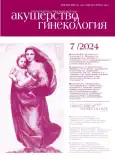Matrix metalloproteinase-9 as a potential marker of preterm birth
- Autores: Skorobogatova O.V., Belousova V.S., Ignatko I.V., Zarova E.A., Bogomazova I.M., Pesegova S.V., Kardanova M.A., Kuzmina T.E.
- Edição: Nº 7 (2024)
- Páginas: 74-80
- Seção: Original Articles
- ##submission.datePublished##: 20.07.2024
- URL: https://journals.eco-vector.com/0300-9092/article/view/635286
- DOI: https://doi.org/10.18565/aig.2024.66
- ID: 635286
Citar
Texto integral
Resumo
Relevance: Preterm birth (PB) is a significant issue worldwide as it is the leading cause of perinatal morbidity and mortality. International statistics indicate that 5–18% of pregnancies result in PB.
Objective: This study aimed to investigate changes in blood plasma and cervicovaginal secretion concentrations of matrix metalloproteinase-9 (MMP-9) in pregnant women with threatened PB, as well as the dynamics of MMP-9 concentrations in response to tocolytic therapy with hexoprenaline.
Materials and methods: We examined 45 pregnant women with threatened PB. The control group consisted of 40 women with healthy pregnancies. The inclusion criterion was a singleton spontaneous pregnancy at 24–31 weeks and 6 days of gestation, with signs of threatened PB. Exclusion criteria were multiple pregnancies, acute phase or exacerbation of chronic diseases, history of cervical pathology, cancer and autoimmune diseases, preeclampsia and its complications, chromosomal abnormalities and congenital fetal malformations, pregnancies resulting from assisted reproductive technologies, and premature rupture of membranes.
Results: Blood plasma MMP-9 concentrations in women with threatened PB and those with normal pregnancies were virtually identical, measuring 116 and 120 ng/ml, respectively. In patients with threatened PB, the mean cervical secretion concentration of MMP-9 was 6.48 pc/g. After tocolytic therapy with hexoprenaline, the concentration decreased to 1.5 pc/g, which was comparable to the cervical secretion concentration of MMP-9 in pregnant women in the control group (1.58 pc/g).
Conclusion: Our study demonstrated that blood plasma MMP-9 cannot serve as a marker of PB because we did not observe any changes in its concentration during threatened PB. However, MMP-9 in cervicovaginal fluid may be considered a marker of PB, as its concentration increases in threatened PB and decreases in response to tocolytic therapy with hexoprenaline, reaching levels typical of a normal pregnancy.
Palavras-chave
Texto integral
Sobre autores
Oksana Skorobogatova
Email: aisha27_sum@mail.ru
ORCID ID: 0009-0009-8664-3536
PhD student at the Department of Obstetrics, Gynecology and Perinatology of the Institute of Clinical Medicine, I.M. Sechenov First MSMU, Ministry of Health
RússiaVera Belousova
Autor responsável pela correspondência
Email: belousova_v_s@staff.sechenov.ru
ORCID ID: 0000-0001-8332-7073
Dr. Med. Sci., Professor at the Department of Obstetrics, Gynecology and Perinatology of the Institute of Clinical Medicine
RússiaIrina Ignatko
Email: ignatko_i_v@staff.sechenov.ru
Dr. Med. Sci., Corresponding Member of the RAS, Professor, Head of the Department of Obstetrics, Gynecology and Perinatology of the Institute of Clinical Medicine
RússiaEvdokia Zarova
Email: zarovaea@mail.ru
ORCID ID: 0000-0003-4693-6886
Student
RússiaIrina Bogomazova
Email: bogomazova_i_m@staff.sechenov.ru
ORCID ID: 0000-0003-1156-7726
PhD, Associate Professor at the Department of Obstetrics, Gynecology and Perinatology of the Institute of Clinical Medicine
RússiaSvetlana Pesegova
Email: pesegova_s_v@staff.sechenov.ru
ORCID ID: 0000-0002-1339-5422
PhD, Teaching Assistant at the Department of Obstetrics, Gynecology and Perinatology of the Institute of Clinical Medicine
RússiaMadina Kardanova
Email: kardanova_m_a@staff.sechenov.ru
ORCID ID: 0000-0002-4315-0717
PhD, Associate Professor at the Department of Obstetrics, Gynecology and Perinatology of the Institute of Clinical Medicine
RússiaTatyana Kuzmina
Email: kuzmina_t_e@staff.sechenov.ru
ORCID ID: 0000-0001-9649-5383
PhD, Associate Professor at the Department of Obstetrics, Gynecology and Perinatology of the Institute of Clinical Medicine
RússiaBibliografia
- Mandy G.T., Weisman L.E., Kim M.S. Incidence and mortality of the preterm infant. UpToDate. Available at: http://www.uptodate.com/contents/incidence-and-mortality-of-the-preterm-infant?search=Incidence%20and%20mortality%20of%20the%20preterm%20infant&source=search_result&selectedTitle=1~150&usage_type=default&display_rank=1
- Министерство здравоохранения Российской Федерации. Клинические рекомендации. Преждевременные роды. 2020. [Ministry of Health of the Russian Federation. Clinical guidelines. Preterm birth. 2020. (in Russian)].
- Ting H.S., Chin P.S., Yeo G.S., Kwek K. Comparison of bedside test kits for prediction of preterm delivery: phosphorylated insulin-like growth factor binding protein-1 (pIGFBP-1) test and fetal fibronectin test. Ann. Acad. Med. Singap. 2007; 36(6): 399-402.
- Eleje G.U., Ezugwu E.C., Eke A.C., Eleje L.I., Ikechebelu J.I., Ezebialu I.U. et al. Accuracy of a combined insulin-like growth factor-binding protein-1/interleukin-6 test (Premaquick) in predicting delivery in women with threatened preterm labor. J. Perinat. Med. 2017; 45(8): 915-24. https://dx.doi.org/10.1515/jpm-2016-0339.
- Дикке Г.Б. Диагностика высокого риска преждевременных родов на основании биохимических тестов. Акушерство и гинекология. 2018; 7: 108-13. [Dikke G.B. Biochemical tests for the diagnosis of high risk of preterm birth. Obstetrics and Gynecology. 2018; (7): 108-13. (in Russian)]. https://dx.doi.org/10.18565/aig.2018.7.108-113.
- Socha M.W., Flis W., Pietrus M., Wartęga M., Stankiewicz M. Signaling pathways regulating human cervical ripening in preterm and term delivery. Cells. 2022; 11(22): 3690. https://dx.doi.org/10.3390/cells11223690.
- Hulboy D.L., Rudolph L.A., Matrisian L.M. Matrix metalloproteinases as mediators of reproductive function. Mol. Hum. Reprod. 1997; 3(1): 27-45. https://dx.doi.org/10.1093/molehr/3.1.27.
- Dymanowska-Dyjak I., Stupak A., Kondracka A., Gęca T., Krzyżanowski A., Kwaśniewska A. Elastography and metalloproteinases in patients at high risk of preterm labor. J. Clin. Med. 2021; 10(17): 3886. https://dx.doi.org/10.3390/jcm10173886.
Arquivos suplementares











